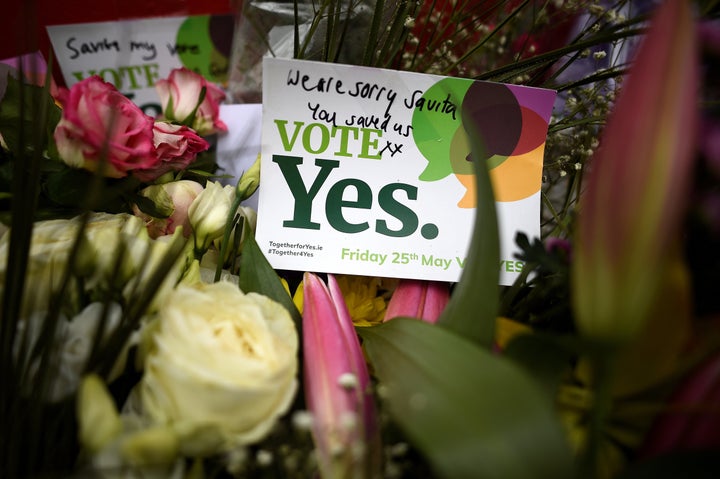
On May 26, Ireland overwhelmingly voted to repeal the Eighth Amendment, lifting one of the world’s most restrictive abortion bans. Though the Irish people recently picked a young biracial gay man to be their prime minister and via referendum allowed same-sex marriage, the landslide victory for abortion rights in a deeply Catholic country came as a surprise.
For many of the pro-abortion-rights Irish voters who fought for this victory, the repeal of the Eighth Amendment is synonymous with the story of Savita Halappanavar, a 31-year old Indian woman who died in a hospital in Galway in 2012 from an infection she contracted after being denied an abortion during a miscarriage.
Halappanavar’s death galvanized a generation of young Irish women to fight for their reproductive freedom because it revealed to them the horrors of the Eighth Amendment and made plain how the law could affect — and even end — their lives. In the days after the historic vote, supporters left messages and flowers at a memorial for Halappanavar in Dublin. “I’m so deeply sorry that you had to suffer,” read one. “You have changed our history and our future.”

On this side of the Atlantic, the political landscape and the future of abortion rights are grim by comparison. The Trump administration is attempting to implement a domestic gag rule that would strip federal funding from health centers that refer patients to abortion. It is working to dismantle Title X, the nation’s only federal grant program for family planning services. Arkansas just became the first state to effectively ban medication abortion. All this despite the fact that 1 in 3 American women will have an abortion in their lifetime and the most recent polls show that the majority of Americans support abortion rights.
What can reproductive health advocates learn from our Irish counterparts who fought against a deeply religious system to prove that, as Prime Minister Leo Varadkar put it, we should “trust women and trust doctors”? The answer might lie in articulating, as explicitly as we can, the critical parallel between abortion access and maternal mortality.
In telling and retelling Halappanavar’s story, Irish pro-abortion-rights activists revealed the hypocrisy and danger of an anti-abortion health care system, in which abortion is labeled a threat to health even as abortion restrictions pose a grave threat to our livelihoods and lives.
“The answer might lie in articulating, as explicitly as we can, the critical parallel between abortion access and maternal mortality.”
Shamefully, the U.S. has the highest maternal mortality rate in the developed world, and the numbers are deeply skewed by race. Maternal mortality rates have reached critical levels for black women, who are almost 3.5 times as likely to die from pregnancy-related complications as white women are. As maternal mortality rates continue to climb in the U.S., research shows that they are rising most in states where access to abortion is diminishing. In Texas the maternal mortality rate shockingly doubled from 2010 to 2014, after the state closed most of its abortion clinics and severely restricted funding to Planned Parenthood.
This should come as no surprise: In states where abortion is heavily restricted, lawmakers are less likely to be invested in reproductive health, and this includes prenatal care and access to other reproductive health services. Texas is a tragic case study for this correlation. Where individuals are denied abortion care, they also tend to be denied lifesaving medical care at other stages of their reproductive lives, including before and after pregnancy. Combating maternal mortality must go hand in hand with ensuring access to safe and legal abortion for everyone who needs it.
Lack of access to abortion can cause maternal death, as in Halappanavar’s case, but it’s more than that. When we restrict abortion access, we force people to go to great lengths to get the care they need, which often means traveling out of state and taking time off work. This is an especially difficult burden for those who are low income.

We also create a more hospitable environment for unsafe and unregulated abortion. The Guttmacher Institute estimates that unsafe abortion takes the lives of 47,000 people worldwide every year, making it a leading cause of maternal mortality and morbidity globally. These are all preventable deaths. Ensuring access to safe, legal abortion, coupled with the promotion of effective contraceptives, is quite literally the only way to reduce complications and mortality rates connected to abortion worldwide.
Abortion is often the only essential health care service not provided by people’s regular reproductive health care provider and within their usual health care system. We know that when abortion is legal, it is extremely safe. It is a basic human right to decide whether and when to have a child without putting your health and very life at stake. When we restrict abortion access, we further marginalize the most vulnerable among us — women, people of color and members of low-income communities.
The U.S. might not have our own Savita Halappanavar, no one person whose story can serve as the catalyst for a nationwide movement for reproductive freedom and health care access. But we shouldn’t need one. Every day, innumerable Americans face extreme absurd hurdles to abortion access, and many will continue to lose their lives if our legislators place their archaic beliefs over our futures.
Halappanavar’s tragic and preventable death changed the history and future of Ireland. The lives prematurely extinguished by the United States’ restrictive laws should change our history and our future too. The debate around abortion is framed as a moral issue. And it is one: If lawmakers care about preserving life, they should be fighting tooth and nail for our right to control our reproductive destinies.
Senti Sojwal is a reproductive justice activist in New York City.
